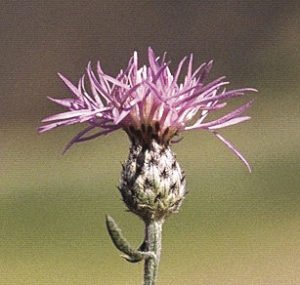Have you ever encountered a patch of Canada thistles along a hiking trail? It’s discouraging to see these and other harmful invasive plants in our wild place. But Canada thistles are only one of the more common invasive plants that can spread along our trails. Many others can hitch a ride on our boots, animals and gear.
Once you realize that you could be accidentally moving harmful invasive species, the first step to avoid doing so is adopting simple action steps to stop unwanted hitchhikers. Invasive plants are most commonly spread by their seed. Picking the weed seeds off your dog and shoe laces can slow their spread. If mowing or grooming a trail, pay attention to the places on your equipment where weed seeds and other plant debris tend to collect. Blow or brush out these areas before moving to a new site. If you bike or use ATVs, they, too, can collect plant debris and inadvertently spread harmful plants. Small boot brushes used to clean the soles of your hiking boots, also work well on bike tire treads and ATVs. The motto to remember is Come Clean, Leave Clean.

Insect and disease pests that attack our forest trees are most commonly spread in firewood or other untreated wood with the bark attached. Immature insects can hide under the bark or deep in the wood and if the wood is not burned right away, these larvae can complete their lifecycle and emerge as adults to mate and attack more trees. Disease agents infect tree bark or vascular tissue where they come into contact with various kinds of insects. Whether the insects are boring into the tree or feeding on the sap, they can carry fungal spores from one tree to another. The best prevention measures are 1) buy only local or certified firewood unlikely to introduce a new tree pest and 2) remove and destroy any infested trees found before the infestation can spread. The motto to remember for tree pests is Buy Local or Certified Firewood.
The next step is to recognize the invasive species that occur in your area. A good place to start is the “dirty dozen” invasive plants listed here:

Common Herbaceous
Invasive Plants
Spotted knapweed Centaurea stoebe
Wild Parsnip Pastinaca sativa
Garlic mustard Alliaris petiolate
Common tansy Tanacetum vulgare
Canada thistle Cirsium arvense
Leafy spurge Euphorbia esula
Harmful Woody
Invasive Plants
Common buckthorn Rhamnus cathartica
Glossy buckthorn Flangula alnus
Japanese knotweed Polygonum japonica
Japanese barberry Berberis thunbergii
Exotic honeysuckle Lonicera spp
Oriental bittersweet Celastrus orbiculatus
The first six listed above can easily hitch a ride on your gear. They all reproduce primarily by seed and their seeds attach themselves to fur, socks, shoelaces, pant cuffs, mowers, trail grooming equipment, etc. and are thus spread long distances with the help of people. These are the ones we can most easily address by cleaning our gear before moving to a new site.

Woody invasive plants can harm our forests and woodlands, and were introduced as ornamental plants for home landscapes. All but knotweed are spread by birds feeding on berries commonly found in town. Knotweed can also be found in town. But rather than producing berries, it produces stem and root fragments that can resprout if dumped off site or moved downstream in flood waters. These are the plants that should be replaced with native species when found in town and reported when found in our woodlands. The motto here is If Your See It, Report It.
Fortunately, checking and reporting the occurrence of invasive species has gotten a lot easier. Www.eddmaps.org, sponsored by a large coalition of state and federal organizations, provides an interactive map where you can look up those species that occur in your area. Once you select your state or county, you can continue to click on the point of interest and the map will zoom in until you can see individual records. Once you sign-up for a free account, you can report your own sightings online and attach photos. It also provides a mobile application that you can use on your smart phone. The application is free and easy to use. You can customize the application by downloading a list of those species you are concerned about, and it will give you a library of species including photos and handy tips to identify each one.
For more information on these invasive species and the steps needed to prevent their spread, visit www.playcleango.org.
Photos provided by www.forestryimages.org.





